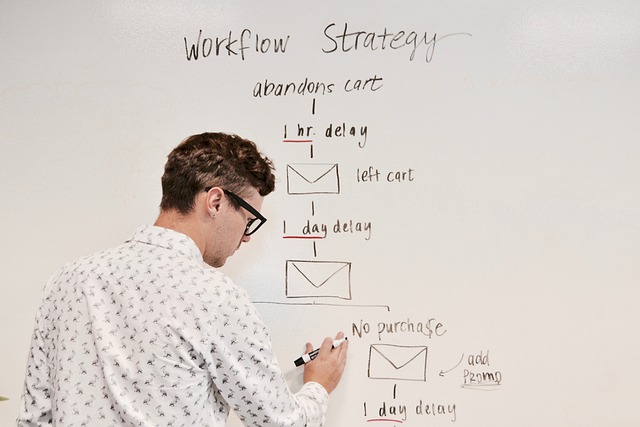What is the best promotional email marketing strategy on the market today? While there are many contenders for the top place, the clear winner is email drip marketing. This strategy is the opposite of blasting customers with random, irrelevant opportunities that do not add value to what they want. If you have never heard of drip marketing, you are in the right place. We want to teach you the best practices of email drip marketing and elevate your business to the next level!
What is email drip marketing?
In a few words, an email drip campaign is a series of timed emails sent to clients depending on their behavior. It is a very high-conversion email marketing strategy. The goal is to engage your clients by sending valuable content and not seeming too pushy about presenting your business. By observing customer behavior, you will be able to understand when they are ready to buy and act accordingly. Keep in mind that even though this is a fantastic strategy to increase your sales, effective email drip marketing can do much more than just sell. You can use it to:
- spread awareness of your brand;
- collect customer data;
- build an engaging and communicative environment for your clients;
- promote new products or offers;
- present any upcoming events.
How to create a successful email drip campaign
Creating an efficient email drip campaign does not mean you have to send a bunch of emails. The number of emails sent will depend on what you’re trying to achieve. An optimal number is anywhere between four and eleven emails a couple of days apart.
For example, let’s look at the setup for a welcome email. When customers register for your newsletter, you can send them a welcoming message. The next day you can send another email to provide more details about your business and welcome them to a group of loyal customers.
Next, pause for about two days and send an engaging email asking relevant questions. After three days, you can send another email providing useful advice regarding your business and introduce the next series of emails. You want to create a story with your emails and lead your customers all the way through it.
How does email automation work
Whatever automation platform you use, the automation process looks similar. You can set various conditions that will trigger the email depending on what the customer does or want. Remember that the more conditions you have, the more complex process becomes. Keep it simple, so you don’t create conflict within the automation platform. Most of all, automation is important because it allows you to save time and maximize the effort of your emails.
Define the trigger
A trigger for an email campaign can be a lot of things. A client may sign up to your website, make the first purchase, or it could be their birthday. If you created a series of emails, ensure they don’t overlap. The customers will feel overwhelmed if you send too many email series at once.
The content matters
Just because you have a loyal customer does not mean you can send them anything you can think of. Pay attention to the content because it matters. Impersonal emails can quickly push away clients. You must ask yourself, what is relevant for your client at the moment? Whatever you send should address their needs.
For example, if a customer has items in their cart but still has not finalized the purchase, you want to send a series of emails to convince them to seal the deal.
Map out the campaign from start to finish
To create a successful email drip campaign, you must map it out first. Identify the campaign goals, define the triggers, and the number of emails you want to send. The next step is to figure out how to personalize the content to match the customers’ needs. And since there are many advantages of personalized email marketing, use that to your benefit when creating such content. Finally, understand when to stop sending emails to a client.
When mapping out this plan, you need to consider not only the emails but also SMS and any other messages you’re planning to send. You want to avoid mistakes like sending a discount to a client for something they purchased the last week. Overlapping messages can create problems with your marketing campaign and lead to dissatisfied clients.
Keep the CTA button visible
No matter what content you add to your email, the most important thing is to have the main goal in mind. You want to convince your clients to take action. Always keep the CTA button visible if you are presenting a new product and giving discounts. You want to simplify the process of taking action by making it possible with just a single click.
Keep emails readable
The most common problem of any email marketing campaign is that clients often don’t read all of the emails. In fact, they might even skip 80% of an email and focus on the main message directly. Try to make your content concise and direct. Do not send a bunch of unnecessary information that they will skip over just to get to the main part.
Remember, the idea is to help them save time while taking action. The best way to accomplish this is to write your emails in small paragraphs. Lengthy walls of text usually seem dull.
Next, introduce headlines and sub-headlines to help your client understand the email content at a glance. Another good piece of advice is to use a bullet point list to make the email easy to read and digest. Furthermore, you can use visuals to make the content more interesting and engaging. As a final piece of advice, use a lot of white space. It will make the email easy on the eyes.
The best practices of email drip marketing – explained!
As long as you follow these best practices of email drip marketing, you will create an engaging and efficient marketing campaign. Keep in mind the campaign’s goal while focusing on the client’s needs. Have their best interests in mind, and your emails will deliver each time!



Recent Comments